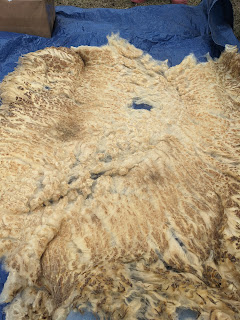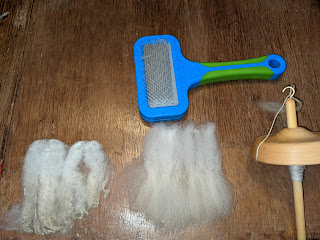Fiber Monday - Raw Fleece
Let's start with the thing I finished.
This is the scarf that L. requested. The picture makes it look blue, but it is actually very purple and black. She is very excited to have it to wear. Sadly, I'm afraid she is still going to get a lot of use out of it before spring actually arrives.
Spring did arrive very briefly on Saturday, so we all did outside things. You know, before the world looked like this again.
This was from this morning. But on Saturday it reminded us all of what nice weather can feel like. I took advantage of it and brought out the raw fleeces I had bought so I could take a good look at them and skirt them. (Skirting is taking off any parts of the fleece that are felted or too dirty or have short second cuts in them.) It is dirty work and not something that I want to do in the house.
First to come out was the large moorit fleece I bought. There were actually two parts. One part was mostly waste, but the shepherd that there might me enough salvageable so sent it along as well.
You can tell it is very dirty. There were also quite a few spots where the wool was totally felted. (You can't spin felted wool.)
See how it all looks compressed and not in separate locks that look fluffy? I was able to salvage a bit, but the rest is going to be used in the garden. (Sheep's fleece is great for using around plants to act like a mulch, keeping down weeds and keeping in moisture.)
The actual fleece is fantastic. This was the first time I got a good look at it. It was also already skirted so I didn't need to do anything with it except put it back in its bag to deal with in real spring.
The discoloration you are seeing is lanolin. It will wash out and the wool should come out very white. Remember this picture? This is from this same fleece.
Finally I got out the Southdown Babydoll fleece. This fleece is... well, I'm glad I didn't pay very much for it. It needed some very heavy skirting and I'm still not sure I skirted it enough. It is very dirty and is full of vegetable matter. In some places it almost feels as though it has more grass than wool in it. It is going to be a very time consuming project to get something spinnable from it. As an experiment, I also washed a small bit of this fleece just to see what it was going to look like. I wasn't overly pleased with what I ended up with and now know I'm going to need to try to be more careful preparing it before washing instead of just taking a huge hunk and washing it that way. Still, I got it as clean was it was going to get, so for the past couple of days I've spent some time trying to pick out most of the vegetable matter and carding it. Wool cards are different than the combs I showed you last week.
These are used for wool that is shorter. The good thing about processing wool this way is there is a lot less waste than with combing. With combing, I showed you the little nests that are created. With cards, you get these.
These are called rolags and they are spun a little differently than the nests. (I know no one really is interested in the differences in how to spin. If you are, let me know and I'll describe it.) You can see that the wool is not entirely white. That's because the fleece was stained yellow, which is called yolk and is from the lanolin. Most of it comes out, but some remains turning the wool a little off white. Since I have no idea what I want to use this fleece for, I've decided that I'm just going to continue cleaning it and carding it. Then when I have it all turned into rolags, I'll decide what I want to do with it. I may try dying the rolags before spinning it as something different. It would also cover the staining, though once spun it will be less noticeable.
I actually am finding that I really enjoy all parts of the spinning process... washing the raw fleece, carding or combing it, and of course, spinning it. I find it all rather soothing. The most difficult piece of it all is figuring out how to do the washing. It is not hard, but can be time consuming. You need to soak it in very hot water (~120 - 140 degrees) in order to clean the lanolin off the wool. Often the wool needs multiple washes and rinses. It would be easy if you could just fill up the bathtub and do it that way, but lanolin melts at high temperatures and solidifies at lower temperatures. Putting water with lanolin in it down you drain would have the same effect of pouring bacon grease down it. I think that J. and I have figured out a way for me to wash fleeces that doesn't involve carrying buckets of hot water about the house. (Because we all know how much I enjoy toting water about.) But because it involves open windows and hoses and working outside, I'm afraid that I won't really be cleaning these fleeces until spring actually arrives. In the meantime, I will continue to do the last wash I need for the brown fleece and keep working on that.









Comments